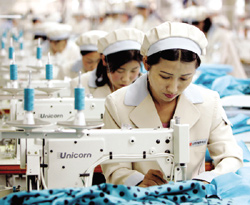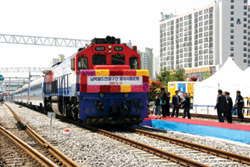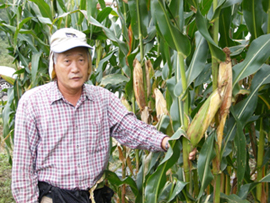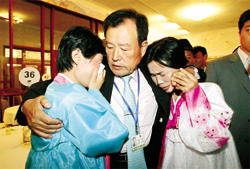Following national division, the two halves of the peninsula became increasingly heterogeneous. Consequently, the South Korean Government has strived to rebuild a national community through inter-Korean exchanges and cooperation rather than rushing to achieve unification.
Gaeseong Industrial Complex

North Korean workers at the Gaeseong Industrial Complex
The Gaeseong Industrial Complex primarily brings the South's capital and technology together with the North's labor and land for mutual gain. The complex is transforming an area of confrontation and tension into one of reconciliation and peace. The Gyeongui Road carries around 600 vehicles and 1,000 South Korean staff and supplies across the Demilitarized Zone daily to feed the needs of existing enterprises and help prepare the industrial zone for newly arriving businesses. As of the end of December 2007, 65 companies are operating in the complex. Throughout that year, they produced $184.78 million dollars worth of goods ― nearly $40 million from exports. Since the GIC's cumulative production value from 2005 was $273.7 million, 2007 clearly saw a marked increase in output.
The Government will make consistent efforts ― based on agreements reached by the two Koreas ― to consult closely with the North Korean authorities and the firms and to monitor developments, so that companies can invest and continue to do business in the complex.
Reconnecting the Inter-Korean Railroad

In 2007, the two Koreas began daily cargo rail service between Munsan, South Korea, and Bongdong, North Korea.
From Dec. 11, 2007, daily freight-train service between the South's Munsan and the North's Bongdong stations began. The linking of inter-Korean railways and roads is advantageous on many levels. Not only does it greatly reduce logistics costs, but it helps diminish inter-Korean tension, speed up development of the Gaeseong Industrial Complex and promote overland tourism to the North's Mt. Geumgangsan Resort. In the future, these railways will link to trans-Siberian or trans-China railways and roads, cementing South Korea's position as a logistics hub for Northeast Asia.
Socio-Cultural Exchanges and Cooperation

Kim Soon-kwon (Dr. Corn): As head of the International Corn Foundation (ICF), Dr. Kim oversaw the development of Super Corn, a cereal engineered to provide bigger yields. In 1998, the ICF transferred super corn seeds to North Korea and began working with their researchers to find new ways to help alleviate chronic food shortages there.
Socio-cultural exchanges in the civil sector are significant in that they contribute to inter-Korean dialogue and accelerate inter-Korean relations overall. To date, civilian-level exchanges have organized regular festivities to mark the June 15 anniversary of the 2000 inter-Korean summit and Liberation Day (Aug. 15), arranged the return to North Korea of a 16th-century Joseon monument taken by imperial Japan during the occupation, and begun work on a joint Korean dictionary. These and other projects aim to restore the oneness of the Korean people. The Government continues to invite North Korean artists to visit, so South Koreans can gain a better understanding of North Korean culture through their creativity and talent. Other efforts to narrow the differences between the two Korean cultures are ongoing: In the sports arena, officials are working to replace one-time events with regular sporting games that can strengthen cooperation between the two Koreas. In the international field, the two Koreas are considering sending a joint cheering squad to the 2008 Beijing Olympics via the inter-Korean Gyeongui Railway.
Reunion of Separated Korean families

Once-divided relatives from the South and North meet at an official family reunion.